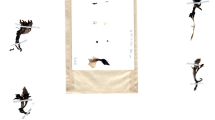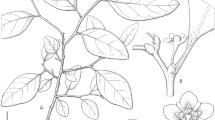Summary
Four species of Mastigostyla (Iridaceae) from Bolivia are described, illustrated and maps of their distribution provided: M. cardenasii R. C. Foster, M. chuquisacensis Huaylla & Wilkin, M. torotoroensis Huaylla & Wilkin and M. woodii Huaylla & Wilkin, the last three as new species. Mastigostyla gracilis R. C. Foster is synonymised under M. cardenasii R. C. Foster. Notes on conservation status, nomenclature and identification are included. Although some uncertainty exists over generic placement due to phylogenetic systematic research now in progress, marked infraspecific variation is documented for the first time within South American Tigridieae. This draws attention to the need for more extensive sampling if adequate species delimitation is to be achieved in Tigridieae. Photographs illustrate morphological variation in all four species. A key is provided to facilitate identification of Bolivian Mastigostyla.








Similar content being viewed by others
References
Barker, C. (2008). World Checklist of Iridaceae. Royal Botanic Gardens, Kew. Published on the Internet; http://www.kew.org/wcsp/ accessed 8 May 2008; 12:30 GMT.
Brako, L. & Zarucchi, J. L. (1993). Catalogue of the flowering plants and gymnosperms of Peru. Monogr. Syst. Bot. Missouri Bot. Gard. 45
Cárdenas, M. (1965). Amaryllis incachacana. Plant Life 21: 55.
Foster, R. C. (1945). Studies in the Iridaceae III. Contr. Gray Herb. 155: 1 – 24.
____ (1946). Studies in the flora of Bolivia. I. Iridaceae Part 1. Contr. Gray Herb. 161: 3 – 19.
____ (1948). Studies in the flora of Bolivia. II. Iridaceae Part 2. Contr. Gray Herb. 166: 28 – 42.
____ (1950). Studies in the Iridaceae VI. Miscellaneous novelties and transfers. Contr. Gray Herb. 171: 22 – 28.
____ (1962). Studies in the Iridaceae, VII. Rhodora 64: 291 – 312.
Goldblatt, P. & Henrich, J. E. (1991). Calydorea Herbert (Iridoideae–Tigridieae): notes on this New World genus and reduction to synonymy of Catila, Cardiostigma, Itysa, and Salpingostylis. Ann. Missouri Bot. Gard. 78: 504 – 511.
____, Manning, J. C. & Rudall, P. (1998). Iridaceae. In: K. Kubitzki (ed.), The Families and Genera of Vascular Plants. Vol. 3, Lilianae (except Orchidaceae), pp. 295 – 333. Springer Verlag, Berlin.
____, Rodriguez, A., Davies, T. J., Manning, J. C., Powell, M. P., van der Bank, M. & Savolainen, V. (2008). Iridaceae ‘Out of Australasia’? Phylogeny, biogeography, and divergence time based on plastid DNA sequences. Syst. Bot. 33: 495 – 508.
Jarvis A., Reuter, H. I., Nelson, A. & Guevara, E. (2008). Hole-filled seamless SRTM data V4, International Centre for Tropical Agriculture (CIAT), available from http://srtm.csi.cgiar.org.
Ravenna, P. (1977). Notas sobre Iridaceae V. Not. Mens. Mus. Nac. Hist. Nat. 21: 7 – 9.
Reeves, G., Chase, M. W., Goldblatt., P., Rudall., P., Fay, M. F., Cox, A. V., Lejeune, B. & Souza-Chies, T. (2000). Molecular Systematics Of Iridaceae: Evidence from four plastid DNA Regions. Amer. J. Bot. 88: 2074 – 2087.
Reuter, H. I., Nelson, A. & Jarvis A. (2007). An evaluation of void filling interpolation methods for SRTM data. Int. J. Geogr. Inform. Sci. 21: 983 – 1008.
Rodriguez, A. & Sytsma, K. J. (2006). Phylogenetics of the “Tiger-flower” group (Tigridieae: Iridaceae) based on molecular and morphological evidence. Aliso 22: 412 – 424.
Vásquez, R. (2001). Redescubrimiento de Hippeastrum incachacanum (Amaryllidaceae). Revista Soc. Boliv. Bot. 3: 256 – 259.
Acknowledgements
The authors would like to thank the following herbaria for the loan of specimens on which this study is based: BOLV, F, GH, HSB, LPB, MO, NY, US and USZ. We would also like to thank John Wood for help with Latin and Spanish translation and in assembling the manuscript. Marcela Celis and an anonymous referee provided review comments which helped to improve the clarity of this paper. We are grateful to Margoth Atahuachi and Magaly Mercado for the use of photographs taken during the Darwin Project, Anna Haigh for assistance at Kew and in the field and Juliet Beentje for Figs 2 and 4 and 6. Hibert Huaylla would like to acknowledge the financial support of the Darwin Initiative (project no. 11-010) of the Department for the Environment, Food and Rural Affairs of the British Government which made possible his study of Iridaceae both in Bolivia and in the United Kingdom.
Author information
Authors and Affiliations
Corresponding author
Rights and permissions
About this article
Cite this article
Huaylla, H., Wilkin, P. & Weber, O. Mastigostyla I. M. Johnst. in Bolivia: three new species and new data on M. cardenasii R. C. Foster. Kew Bull 65, 241–254 (2010). https://doi.org/10.1007/s12225-010-9199-y
Accepted:
Published:
Issue Date:
DOI: https://doi.org/10.1007/s12225-010-9199-y




